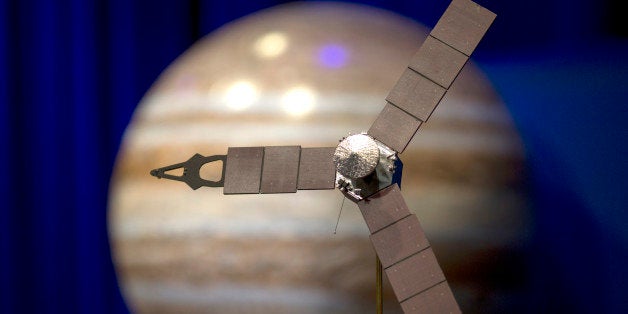
The national fireworks on July 4 this year will be joined by celestial fireworks as NASA's Juno mission arrives at Jupiter after five years of travel from Earth. Principals of the mission and its scientific experiments discussed the plans for the orbital insertion at a press conference at NASA's Jet Propulsion Laboratory in Pasadena, CA, today, as Juno reached Jupiter's doorstep. Juno, in Roman mythology, was the wife of the king of the gods, Jupiter.
Juno's path is to thread a needle between Jupiter's radiation belts and its atmosphere. Starting at 11:18 pm EDT (8:18 pm PDT) on July 4's evening, the spacecraft will burn its main engine to slow it from its 165,000 mph speed with respect to Earth, one of the highest speeds ever reached. The burn should last 35 minutes, until 11:53 pm EDT (8:53 pm PDT). Eager scientists and engineers, joined by journalists and those watching on NASA TV around the world, will listen for a beep at the beginning of the engine burn and another beep at the end of the burn, hoping that the exact timing indicates a successful insertion into a polar orbit around Jupiter. All action actually took place 48 minutes earlier, since the radio signals from Jupiter currently take 48 minutes to travel to Earth at the speed of light. The last commands to Juno are being sent today; the spacecraft will then be on its own for a few days, though, of course, it will be monitored.
It will then take a couple of days before the instruments are turned on. The spacecraft has been made to spin faster than previously, 5 rpm, to improve its stabilization before the burn; it will be slowed to 2 rpm for its science observations. Not since the Pioneer spacecraft has rotation been used for stabilization, but this spacecraft is in one of NASA's smaller (and less expensive) spacecraft series, following on the very successful New Horizons spacecraft that flew by Pluto last year.
Most of the instruments deal with Jupiter's particles and magnetic field, which is 20,000 times more powerful than Earth's. The main instruments, to protect them, are in a vault made of 400 pounds of titanium to protect them from high radiation. The Junocam, its imaging camera, is outside that protection, and may not last as long as other instruments; further, it will give images as it rotates that will have to be transformed to the equivalent of steady views.
Juno's instruments will be powered by huge solar panels; end to end, the spacecraft would fill a basketball court from hoop to hoop. A boom at the end of one arm extends even further, to put the magnetic-field measuring equipment as far from the metal at the spacecraft's center as possible, to minimize distortions.
When the planets of our solar system formed about 5 billion years ago, Jupiter took up about half the leftover material besides the Sun. Juno's main goals include discovering what the inside of Jupiter is like, as part of understanding how the planets formed. One specific goal is to discover whether Jupiter has a rocky or ice core of elements heavier than helium. It has been estimated as being 10 to 20 times the Earth's mass; though dense, it is not necessarily solid, even under the huge pressure near Jupiter's center.
Juno will be in an extended elliptical orbit, coming as close as only 5000 miles above the cloudtops at its lowest point. Its 14-day elliptical orbit will be timed so that each time it comes close it passes a few degrees in longitude around the planet, so that by the time it completes three dozen orbits after about a year, it will have mapped the planet at high accuracy completely. But unlike previous spacecraft to Jupiter, it is concentrating on a layer under the visible cloud deck, where the magnetic field is apparently formed. That layer stays much steadier than does Jupiter's atmosphere above it.
Jupiter's magnetosphere is huge; if we could see it, it would appear as big as our Moon appears in our sky. We know from measuring radio signals from Jupiter that the magnetic field rotates like clockwork, even though the cloud deck rotates at different speeds at different latitudes. The magnetic field generates a huge, fairly steady aurora, over twice as large as Earth. The spacecraft has been traveling within Jupiter's magnetosphere, where the magnetic field dominates, for about a week.